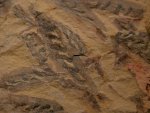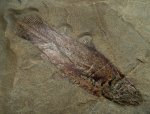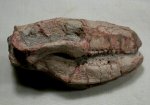Visit
these fossil dealer shops currently stocking vertebrate
fossils:
EDCOPE
Enterprises
About
Vertebrate Fossils
 A
vertebrate is an animal with a backbone, which incidentally
comprises only about 5% of all described animal species.
Vertebrates are formally contained in subphylum Vertebrata,
the largest subphylum of Phylum Chordata that fishes, dinosaurs,
reptiles, and of course mammals including humans. For the
organization of taxa in Fossil Mall, vertebrate constitutes
a moniker for anything not included in invertebrates or any
other specific category such as fish fossils, dinosaur and
reptile fossils, and so forth. An often used simple taxonomy
for Subphylum Vertebrata comprises seven paraphyletic classes:
Agnatha (jawless fish), Chondrichthyes (cartilaginous fishes),
Osteichthyes (bony fishes), Amphibia
A
vertebrate is an animal with a backbone, which incidentally
comprises only about 5% of all described animal species.
Vertebrates are formally contained in subphylum Vertebrata,
the largest subphylum of Phylum Chordata that fishes, dinosaurs,
reptiles, and of course mammals including humans. For the
organization of taxa in Fossil Mall, vertebrate constitutes
a moniker for anything not included in invertebrates or any
other specific category such as fish fossils, dinosaur and
reptile fossils, and so forth. An often used simple taxonomy
for Subphylum Vertebrata comprises seven paraphyletic classes:
Agnatha (jawless fish), Chondrichthyes (cartilaginous fishes),
Osteichthyes (bony fishes), Amphibia  (amphibians), Reptilia
(reptiles that include dinosaurs), Aves (birds that are descended
from and considered a type of dinosaur), and Class Mammalia
(mammals).
(amphibians), Reptilia
(reptiles that include dinosaurs), Aves (birds that are descended
from and considered a type of dinosaur), and Class Mammalia
(mammals).
 Vertebrate
evolution can be dated to a time known as the Cambrian
Explosion some 525 million years ago. The fossil record shows
that this Cambrian
period was when most
animal phyla first appeared. The earliest known
vertebrates are thought to be the basal chordates Myllokunmingia
and Haikouichthys, both coming from the lower Cambrian Chengjiang
Maotianshan Shales. Jawed vertebrates appear in the Ordovician
fossil record, and become common in the Devonian, a period
often called the age of fishes. The two groups of bony fishes,
the actinopterygii and sarcopterygii, evolved and became
common in the Devonian, while jawless fishes except lampreys
and hagfish
became extinct. Transitional animals between fish and amphibians
first appear in the Devonian fossil record.
Vertebrate
evolution can be dated to a time known as the Cambrian
Explosion some 525 million years ago. The fossil record shows
that this Cambrian
period was when most
animal phyla first appeared. The earliest known
vertebrates are thought to be the basal chordates Myllokunmingia
and Haikouichthys, both coming from the lower Cambrian Chengjiang
Maotianshan Shales. Jawed vertebrates appear in the Ordovician
fossil record, and become common in the Devonian, a period
often called the age of fishes. The two groups of bony fishes,
the actinopterygii and sarcopterygii, evolved and became
common in the Devonian, while jawless fishes except lampreys
and hagfish
became extinct. Transitional animals between fish and amphibians
first appear in the Devonian fossil record.

 (amphibians), Reptilia
(reptiles that include dinosaurs), Aves (birds that are descended
from and considered a type of dinosaur), and Class Mammalia
(mammals).
(amphibians), Reptilia
(reptiles that include dinosaurs), Aves (birds that are descended
from and considered a type of dinosaur), and Class Mammalia
(mammals). Vertebrate
evolution can be dated to a time known as the Cambrian
Explosion some 525 million years ago. The fossil record shows
that this Cambrian
period was when most
animal phyla first appeared. The earliest known
vertebrates are thought to be the basal chordates Myllokunmingia
and Haikouichthys, both coming from the lower Cambrian Chengjiang
Maotianshan Shales. Jawed vertebrates appear in the Ordovician
fossil record, and become common in the Devonian, a period
often called the age of fishes. The two groups of bony fishes,
the actinopterygii and sarcopterygii, evolved and became
common in the Devonian, while jawless fishes except lampreys
and hagfish
became extinct. Transitional animals between fish and amphibians
first appear in the Devonian fossil record.
Vertebrate
evolution can be dated to a time known as the Cambrian
Explosion some 525 million years ago. The fossil record shows
that this Cambrian
period was when most
animal phyla first appeared. The earliest known
vertebrates are thought to be the basal chordates Myllokunmingia
and Haikouichthys, both coming from the lower Cambrian Chengjiang
Maotianshan Shales. Jawed vertebrates appear in the Ordovician
fossil record, and become common in the Devonian, a period
often called the age of fishes. The two groups of bony fishes,
the actinopterygii and sarcopterygii, evolved and became
common in the Devonian, while jawless fishes except lampreys
and hagfish
became extinct. Transitional animals between fish and amphibians
first appear in the Devonian fossil record.


